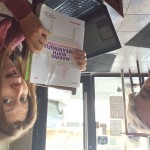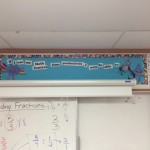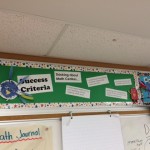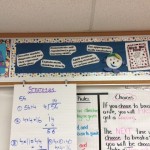Experts (i.e., Dweck, Boaler, Small, Burns), suggest that educators’ and learners’ beliefs (self or subject) are critical to mathematical achievements. From our teaching experiences as mathematics teachers, we have learned that by the time students enter middle school, a wide range of skills, abilities and beliefs about self and mathematics pre-exists. Especially in a rotary system, where teachers may see many classes for short amounts of time throughout the day or week, the individual needs of some students may slip through the cracks.
The purpose of this project was to develop a practical, research-based approach to differentiated instruction and assessment that enables every student to believe in themselves as a mathematical learner.
Through the use of age-appropriate math centres, students would become engaged in a variety of math problems, have opportunities to practise and consolidate basic facts and operational skills, use technology and manipulatives as learning tools, become clearer and more precise communicators in math, and develop a sense of self-awareness when it comes to their math skills. Students would also grow in their ability to work independently and cooperatively as they work through various math centres, allowing the teacher(s) to conference with individuals and small groups of students.
Team Members
Vera C. Teschow
PDSB
Lise Grimwood
PDSB
Amanjot Toor
PDSB
Professional Learning Goals
- develop a practical, differentiated math program structure that allows students to engage in purposeful practice while freeing up the teacher to meet with individual and small groups of students for teaching and/or assessment purposes
- increase professional knowledge of and comfort with technology in the math class
- increase assessment and instructional effectiveness and efficiency in the rotary context while utilizing “Balanced Mathematics Instruction, K-12″ pedagogical approach
Activities and Resources
Professional reading (board, ministry and privately published resources)
We each read a number of ministry monographs, and became considerably more comfortable with and knowledgeable about the Math Curriculum Document, in particular the math processes. Marian Small’s books were also quite helpful in unit planning.
Small group training with instructional coach and/or Instructional Tech resource person to learn about D2L, Office 360 and/or Clips for Math and how to integrate them successfully (and realistically) into the classroom
We met early on with our Instructional Tech resource teacher, who encouraged us to explore a variety of tech options, and showed us some ways tech could be used by teachers and students. The meeting was a good “kick-start” in the fall, but rather too short as there is SOOOO much to learn!
Visit other schools/classrooms that are effectively using a “guided” or centres-based approach to math
We attempted several times to visit other schools, but were not successful in coordinating schedules. We did, however, manage to visit one another’s classrooms, which was quite insightful for both of us. As word got out about our project, we also hosted a number of visitors in our rooms. These visitors asked many questions that helped us to think about what we were doing and why.
Attend OAME conference in May 2015
Two of our team members attended the Math Educators’ conference in May, attending keynotes and other sessions, and facilitating a double session about our project.
Meetings with Instructional Coach
Regular meetings with our instructional coach helped us to learn about new resources and stay focused in our planning. In particular, she challenged us to really match up our assessment and our centres to specific learning goals and success criteria for the students.
Unexpected Challenges
Scheduling
As the two classroom teachers on our team teach different grades in different buildings (our school comprises two buildings), it was somewhat challenging to coordinate schedules. Although we collaborated less frequently and closely than we had initially planned, this had the unexpectedly positive result of providing us with two vantage points for our initial idea; when we did meet again in the spring after our initial fall planning meetings, we discovered that we had each taken a different approach to the centres idea, and ended up really learning from one another.
We were also able to bring newcomers on board, and extended the invitation to other teachers to receive a half-day release time to participate in a centres-based classroom and debrief afterwards, sharing their observations and ideas to refine the concept.
Student Resistance
Since we teach intermediate students, our classes have largely already built their schema around how math class is “supposed” to go… of the several classes taught between the two of us, one in particular was quite resistant to the centres-based approach. This resistance resulted in a number of complexities we had not anticipated.
Enhancing Student Learning and Development
One student noted, on the anonymous feedback survey we distributed, “Centres are the best way to learn more in math. Doing a lesson for like 20 minutes is just a waste of time, especially working in a textbook.”
Indeed it was fulfilling to see the growth in both mathematical understanding and mindset in some of our most struggling learners, when they were afforded some much needed 1:1 time with a teacher. Some who had hitherto shunned math began to really participate, and we were able to witness the neurons firing!
Many students also grew in their ability to self-regulate, as they had to make choices about what to work on, for how long and with whom.
Despite many of these positives, there were some drawbacks. We believe these were due primarily to the fact that some students just needed more time with the model. For Grade 7 and 8 students who had only ever experienced a textbook in math, this approach was a significant departure from what they were used to and comfortable with… even if they never liked math to begin with.
With an earlier start (Grade 5 or 6 at the latest), students would perhaps be more open to this self-directed approach, and become better able to glean its benefits.
Sharing
- One of our team members tweeted about our work periodically.
- One of our members publishes a blog, and much of the work was shared there. The readership is between 300 – 700 page views per day on average, mainly teachers.
- Two of our team members co-facilitated a session at OAME to approximately 35 teachers.
- One of our members was involved in completing her PhD, and was able to share with and receive feedback from her colleagues through the Congress of European Research in Mathematics Education.
Project Evaluation
Did we all learn a lot?
YES! About learning goals and success criteria, about math, about descriptive feedback…
- We were able to develop a practical, differentiated math program structure that allowed students to engage in purposeful practice while freeing up the teacher to meet with individual and small groups of students for teaching and/or assessment purposes.
- We increased professional knowledge of and comfort with technology in the math class, attending math workshops and sessions on technology (including several OTF connects sessions), and trying out new ideas like Kahoot! for classroom assessments and reviews.
- We increased assessment and instructional effectiveness and efficiency by developing criteria-based assessment templates for various units.
What we’d do differently:
- more time spent up front (in Sept/Oct) getting students “on-board”
- more communication with families earlier in the year about our goals and how the project is intended to support their children
- take two release days back-to-back to build on momentum and get jobs done more effectively and efficiently
Resources Used
Small, Marian. Good Questions: Great Ways to Differentiate Mathematics Instruction.
Small, Marian. Big Ideas from Dr. Small, Grades 4-8.
Small, Marian. Making Math Meaningful to Canadian Students, K-8.
Small, Marian. Eyes on Math.
Parrish, Sherry. Number Talks, Helping Children Build Mental Math and Computation Strategies.
Watt, Jennifer and Jill Colyer. IQ: A Practical Guide to Inquiry-Based Learning.
Dan Myer’s blog, 3-Act Math
Kyle Pearce “Tap Into Teen Minds”
Resources Created
These resources will open in your browser in a new tab, or be downloaded to your computer.






